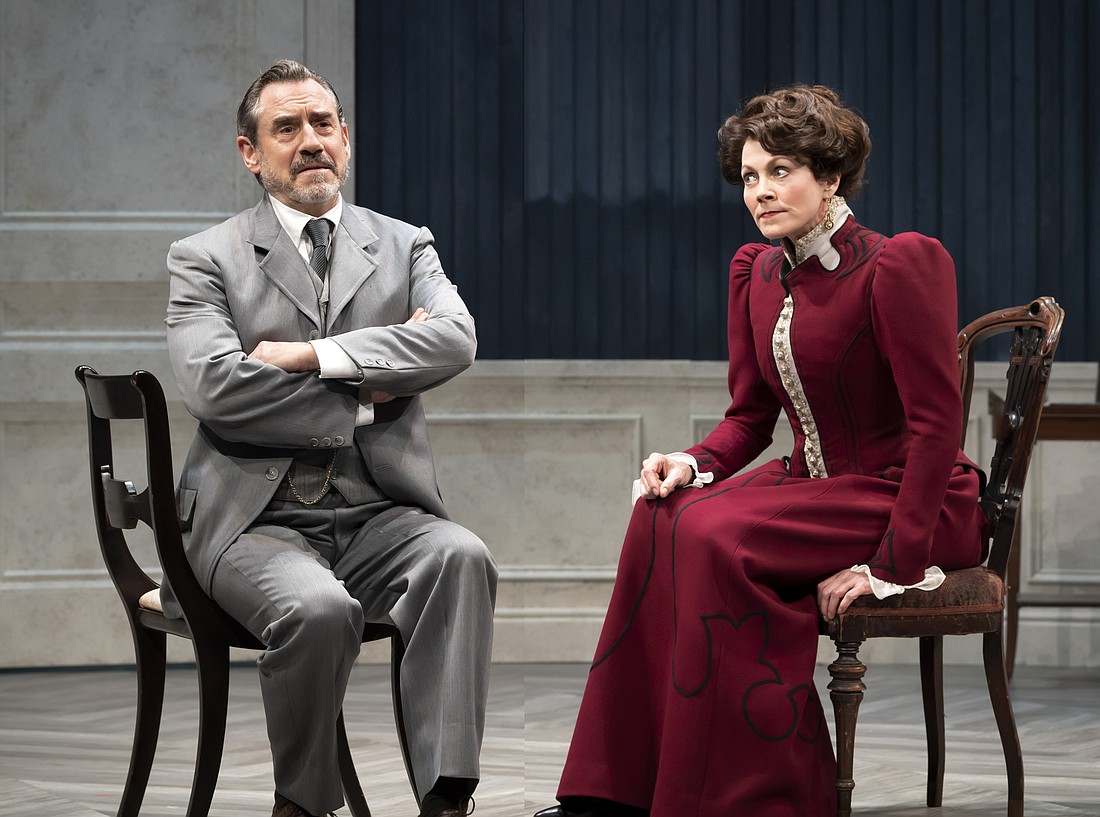- April 18, 2024
-
-
Loading

Loading

Lucas Hnath’s “A Doll’s House, Part 2” imagines a new chapter to Ibsen’s convoluted classic with Asolo Repertory Theatre. Whatever happened to Nora Helmer? In case you were wondering, Hnath provides one possible answer.
Previously in “The Doll’s House,” Nora endured incredible self-sacrifice to save her husband Torvald’s health and reputation. She did it secretly, because he didn’t take her seriously. Torvald saw her as a pretty bird in a gilded cage. (Or, doll in a dollhouse, to switch metaphors.) When Torvald realized what Nora had done, he first rejected her, and then forgave her. That’s when Nora realized she was invisible to Torvald. She left, slamming the door behind her.
Hnath picks up where Ibsen left off, 15 years later.
Knock-knock.
Nora’s back. Rumors of her death have been greatly exaggerated.
Long story short: Torvald (David Breitbarth) never signed the divorce papers; Nora (Kate Hampton) blithely assumed he had. After a few harsh years of early struggle, she wrote a series of best-sellers urging wives to follow her door-slamming example. Her literary legend revolved around her bold escape from a bad marriage. Nora wrote under a pseudonym. But a cranky judge (whose wife had followed Nora’s advice) uncovered her real name and marital status. Now, he’s threatening to expose Nora, unless she recants her feminist stand. Besides hurting book sales, that could land her in prison. (Wives couldn’t sign contracts without their husband’s permission under 19th-century Norwegian law.) If Nora’s still married, she’s guilty of fraud. To escape this threat, she needs a real divorce. That’s what she wants from Torvald. That’s why she’s back.
OK, it’s not such a short story. And Nora’s story is just getting started.
The rest of Hnath’s play triangulates themes of female empowerment, childhood abandonment and the power of narrative. Nora’s novels paint an ugly portrait of her ex-husband. Was Torvald really the bad guy? (He doesn’t recall being a patronizing paterfamilias.) What was it like for the children Nora left behind? What about the women (and men) who dream of a dollhouse marriage? What about working-class people who can’t afford grand gestures?
Hnath digs into the issues Ibsen originally wrestled with — and the future implications he never considered. The playwright takes the philosophy seriously. But he’s not above cracking post-modern jokes. Running gags, of the self-aware, self-referential variety.
Critics speculate that Nora probably died after she left. In Hnath’s play, everybody tells Nora, “I thought you were dead.” Nora also (in soapbox speeches worthy of Eddie Albert on “Green Acres,”) periodically dreams of a bright future where men and women are equals and marriage is a thing of the past. It could happen 25 years from now …
Director Peter Amster finds the right tone — and it’s not easy. This isn’t satire. This isn’t a dead-serious sequel, either. The playwright wants to have it both ways. But Amster skates beautifully on the Hnath’s thin ice.
Hampton’s Nora gets a heap of applause lines. Her high-and-mighty character quickly grows tiresome. Hampton’s voice work reminds me of Jane Fonda’s character in Grace and Frankie. (Either a conscious acting choice or a happy accident.) Breitbarth’s Torvald earns your sympathy — and that’s not easy. He’s the designated fall guy; the straw man; the patriarchal Charlie Brown kicking Nora’s feminist football. “I can’t win with you!” he hollers. It’s true. Peggy Roeder’s servant sprinkles her dialog with anachronistic f-bombs. Scripted, yes, but her delivery is hilarious. Olivia Osol’s Emmy is clearly her mother’s daughter. Or her mother’s anti-particle — the anti-Nora. Her Emmy is cool and calculating, though her calculations add up differently.
Robert Perdziola’s semi-circular set evokes a dollhouse without a doll. There’s almost no furniture, and the walls are stripped of paintings. Torvald burned all of Nora’s stuff and sold the rest. (There’s no mailbox on that famous front door. Evidently, Torvald got rid of it.) His costumes follow a similar paper doll template. They’re obviously artificial signifiers of identity.
Obvious artificiality is the typical post-modern point.
Laughter rarely is.
Post-modernist comedy is usually funny on a conceptual level. Which is another way of saying it’s not funny. Hnath is actually funny. I knew he was clever, thanks to “Isaac’s Eye.” That play made me think. This play makes me laugh.
Who knew?